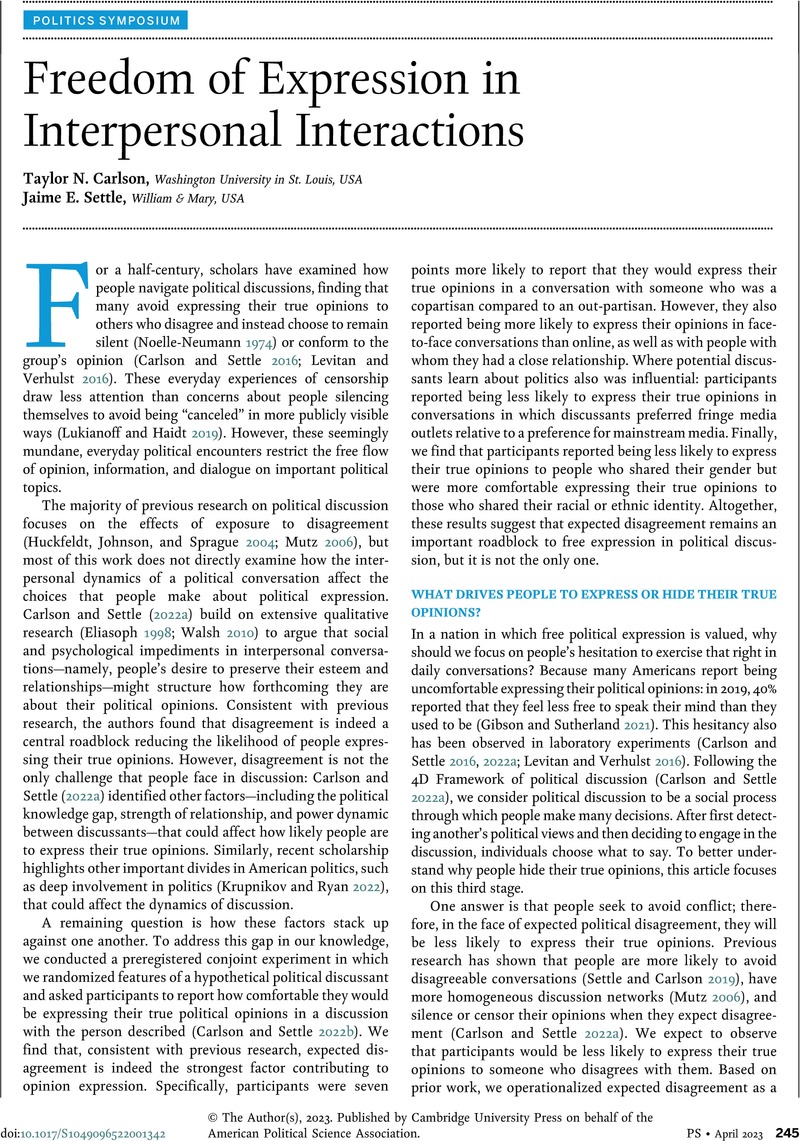No CrossRef data available.
Article contents
Freedom of Expression in Interpersonal Interactions
Published online by Cambridge University Press: 05 January 2023
Abstract
An abstract is not available for this content so a preview has been provided. Please use the Get access link above for information on how to access this content.

- Type
- Freedom of Expression in an Age of Social Media, Misinformation, and Political Polarization
- Information
- Copyright
- © The Author(s), 2023. Published by Cambridge University Press on behalf of the American Political Science Association
References
REFERENCES
Ahn, T. K., Huckfeldt, Robert, and Ryan, John Barry. 2014. Experts, Activists, and Democratic Politics: Are Electorates Self-Educating? Cambridge: Cambridge University Press.Google Scholar
Bansak, Kirk, Hainmueller, Jens, Hopkins, Daniel J., Yamamoto, Teppei, Druckman, James N., and Green, Donald P.. 2021. “Conjoint Survey Experiments.” In Advances in Experimental Political Science, ed. Druckman, James N. and Green, Donald P., 19–41. Cambridge: Cambridge University Press. DOI:10.1017/9781108777919.004 19.CrossRefGoogle Scholar
Carlson, Taylor N., and Settle, Jaime E.. 2016. “Political Chameleons: An Exploration of Conformity in Political Discussions.” Political Behavior 38 (4): 817–59.CrossRefGoogle Scholar
Carlson, Taylor N., and Settle, Jaime E.. 2022a. What Goes Without Saying: Navigating Political Discussion in America. Cambridge: Cambridge University Press.CrossRefGoogle Scholar
Carlson, Taylor N., and Settle, Jaime E.. 2022b. “Replication data for ‘Freedom of Expression in Interpersonal Interactions.’” PS: Political Science & Politics. DOI:10.7910/DVN/FNHEVD.CrossRefGoogle Scholar
Connors, Elizabeth C., and Howell, Christopher. n.d.. “‘You Need to Calm Down’: How Tone Shapes Political Discussions.” Paper under review. Columbia: University of South CarolinaGoogle Scholar
Eliasoph, Nina. 1998. Avoiding Politics: How Americans Produce Apathy in Everyday Life. Cambridge: Cambridge University Press.CrossRefGoogle Scholar
Gibson, James L., and Sutherland, Joseph L.. 2021. “Keeping Your Mouth Shut: Spiraling Self-Censorship in the United States.” Unpublished manuscript. https://papers.ssrn.com/sol3/papers.cfm?abstract_id=3647099.CrossRefGoogle Scholar
Huckfeldt, Robert, Johnson, Paul E., and Sprague, John. 2004. Political Disagreement: The Survival of Diverse Opinions Within Communication Networks. Cambridge: Cambridge University Press.CrossRefGoogle Scholar
Jurkowitz, Mark, Mitchell, Amy, Shearer, Elisa, and Walker, Mason. 2020. “U.S. Media Polarization and the 2020 Election: A Nation Divided.” Washington, DC: Pew Research Center. www.pewresearch.org/journalism/2020/01/24/u-s-media-polarization-and-the-2020-election-a-nation-divided.Google Scholar
Krupnikov, Yanna, and Ryan, John Barry. 2022. The Other Divide: Polarization and Disengagement in American Politics. Cambridge: Cambridge University Press.CrossRefGoogle Scholar
Leeper, Thomas J., Hobolt, Sara B., and Tilley, James. 2020. “Measuring Subgroup Preferences in Conjoint Experiments.” Political Analysis 28 (2): 207–21.CrossRefGoogle Scholar
Levitan, Lindsey C., and Verhulst, Brad. 2016. “Conformity in Groups: The Effects of Others’ Views on Expressed Attitudes and Attitude Change.” Political Behavior 38 (2): 277–315.CrossRefGoogle Scholar
Lukianoff, Greg, and Haidt, Jonathan. 2019. The Coddling of the American Mind: How Good Intentions and Bad Ideas Are Setting up a Generation for Failure. London: Penguin Books.Google Scholar
Mutz, Diana C. 2006. Hearing the Other Side: Deliberative Versus Participatory Democracy. Cambridge: Cambridge University Press.CrossRefGoogle Scholar
Noelle‐Neumann, Elisabeth. 1974. “The Spiral of Silence: A Theory of Public Opinion.” Journal of Communication 24 (2): 43–51.CrossRefGoogle Scholar
Settle, Jaime E. 2018. Frenemies: How Social Media Polarizes America. Cambridge: Cambridge University Press.CrossRefGoogle Scholar
Settle, Jaime E., and Carlson, Taylor N.. 2019. “Opting out of Political Discussions.” Political Communication 36 (3): 476–96.CrossRefGoogle Scholar
Van Duyn, Emily. 2018. “Hidden Democracy: Political Dissent in Rural America.” Journal of Communication 68:965–87.CrossRefGoogle Scholar
Walsh, Katherine Cramer. 2010. Talking about Politics. Chicago: University of Chicago Press.Google Scholar




